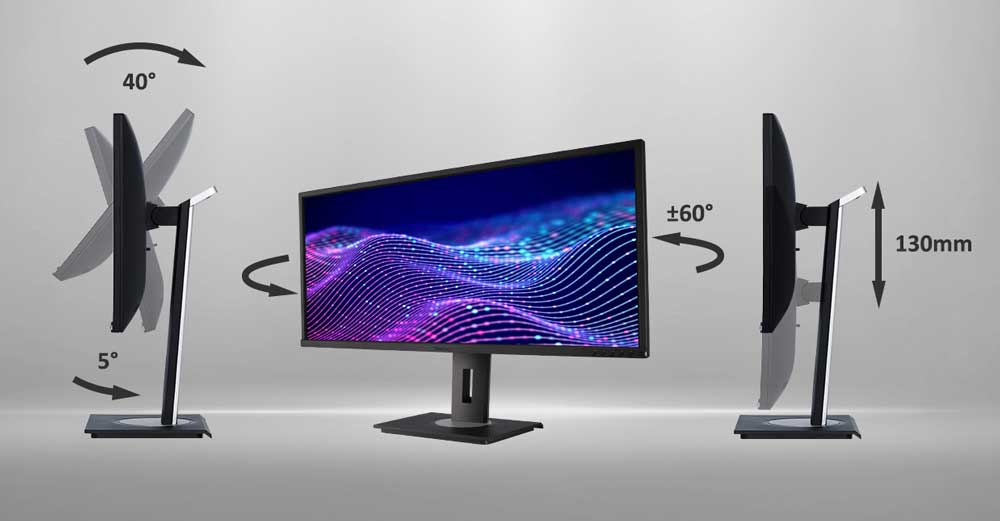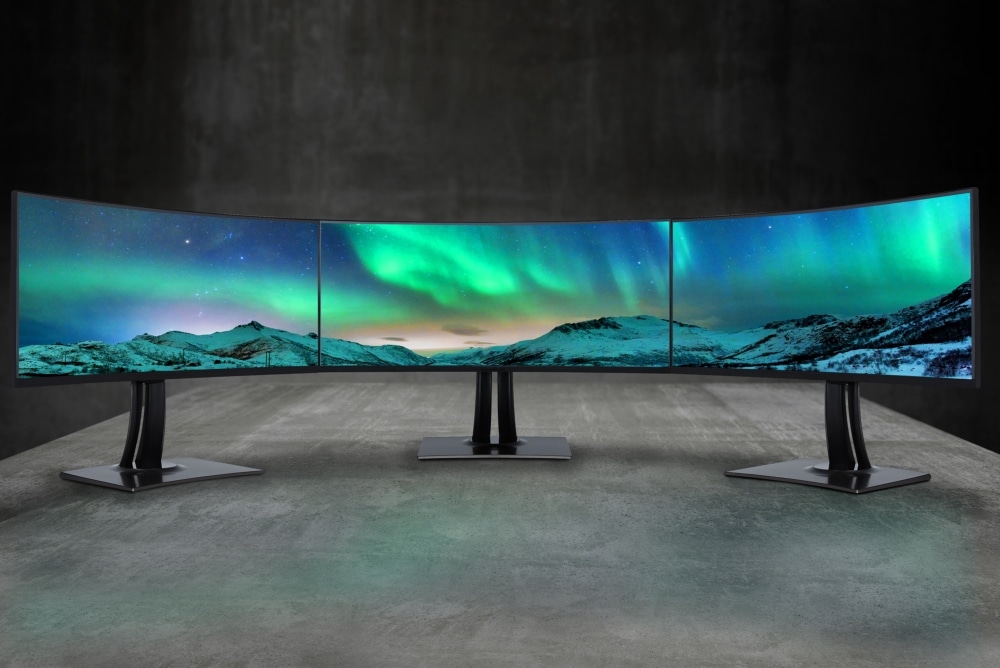A number of factors go into the best computer monitor for business. It all starts with you and your business’s needs. But it extends to the screen performance, ergonomics, and screen configuration that best facilitates your work. Plus you’ll need to make certain adjustments to accommodate either individual work or collaboration. But luckily, we go into all that an more in this comprehensive post about finding an efficient display for your work.
Keep reading to learn everything you need to know about buying a monitor for business. Or look at some of ViewSonic’s office monitor solutions here.
In the modern, screen-centric workplace, there’s no such thing as a single best computer monitor for business. Instead, the perfect solution for each person will vary depending on their personal needs, their assigned workspace, and their job function.
To determine what the best business computer monitor for any employee might be, you need to review the factors that go into choosing a monitor, and then assess the different setups that are available on the market today.
Productivity: Saved Clicks Add Up
Every movement we make affects our productivity in some way. Imagine you’re staying at a hotel in another country and you head down to the business center to churn out a few quick emails—or so you think. The trouble is, the keyboards there use a different layout, and you find yourself struggling to adjust. A task that should have taken 15 minutes takes an hour instead as you hunt-and-peck your way through your messages.
The same is true of monitor usage: efficient use of screen real estate can save us time in terms of toggling or clicking back and forth. If you use a single, regular-width monitor, and you’re developing a PowerPoint presentation based on information available in a spreadsheet, you’ll find yourself constantly minimizing and maximizing windows.
Change your setup so that you’re using two monitors or a single ultra-wide one, and you’ll find that you’re able to complete your work much more quickly.
Screen Performance: Color, Detail, and More
Some employees may require higher levels of screen performance than others. Certain types of work—especially graphic design, photo, and video editing, and CAD/CAM work—mean that color, detail, surface, picture quality, and other aspects of the monitor have a significant impact on day-to-day performance.
An employee whose job revolves around photo editing, for example, will have specific requirements involving color space, adjustable gamma settings, matte screen surfaces, and hardware color calibration.
ViewSonic® VP series monitors, aimed at professionals for whom color is central to their work, can be calibrated using the ViewSonic® CS-Xri1 Colorbration™ Kit, which includes a colorimeter, paired with a software application that allows for a long-term color accuracy solution. Some monitors also offer a dual color engine, meaning that editors can use two separate color settings simultaneously on one widescreen monitor, effectively using one monitor to do the work of two.

Ergonomics: Create Your Ideal Workspace
Studies have shown that after four hours of work, more than half of employees feel moderate or severe discomfort caused by their workstation.
When we think of office ergonomics, we often think of chairs, mice, and keyboards. But monitors play a large role in ensuring that we have an ergonomically correct setup.
The wrong monitor can irritate your eyes, causing dryness, fatigue, or irritation, in addition to inducing headaches. By using LED backlights, ViewSonic’s Flicker-Free technology helps to reduce the risk of eye fatigue and associated issues, ensuring that your eyes feel as well-rested at the end of your workday as they did at the beginning.
Likewise, if you work at your computer in the evenings, the blue light that your monitor emits can interfere with your sleep patterns. The vast majority of ViewSonic monitors offer an integrated blue light filter, which offers the ability to reduce blue light by up to 87%.
For photographers and designers, ViewSonic’s AutoPivot functionality allows for easy switching between landscape and portrait view, reducing neck strain (and saving time). When you rotate the monitor, a built-in sensor rotates the image onscreen accordingly.
Those who don’t work on detailed imagery can still benefit from a range of features that allow for on-the-spot ergonomic adjustments. The best computer monitors for business use are the ones that adjust to each employee’s needs—there’s no such thing as a one-size-fits-all desk setup.
Adjustability is the key word here: mounts that allow for tilting and swiveling, as well as tweaks to the height of the monitor, are ideal for ensuring that your screen is correctly positioned. And adjustability can help with continuity as well: if you use a hot-desking setup, for example, each employee can adjust the monitor’s height and angle before beginning work.

Collaboration vs. Individual Work
We’ve already taken into account how we work when talking about the best computer monitors for business use. Still, another consideration is who we work with. If you’ve ever spent time craning their neck or squinting at a faraway screen, trying to make heads or tails out of a line of text that appears a fraction of an inch high, you’re not alone. The best business monitors allow for group viewing with ease.
Individuals who often find themselves with a group of colleagues gathering around their desks might prefer a monitor that easily swivels so that they can view the screen together. Elsewhere, such as in a huddle room, a wall-mounted ultrawide monitor will be ergonomically comfortable for group viewing, while its size will allow for the zoomed-in display of key content, saving your eyes from strain and fatigue.
Other Characteristics
There’s no detail too small when it comes to determining what the best business monitor is for your needs. For example, you may have a narrow bezel around their screen so as not to disrupt your focus; others may be most concerned about having a matte screen due to an influx of natural light in their workspace.
Personal preferences matter when it comes to selecting the best computer monitors for business purposes; after all, the best monitor is the one that works for you and your specific role.
How Different Monitor Setups Can Improve Your Workflow
After taking into account your individual needs and preferences, consider that a non-traditional monitor setup may be the right fit for you. Dual-monitor setups, ultrawide monitors, and curved monitors all have specific characteristics that can simplify and streamline work processes.

Dual Monitor Setups
Ask people who work with a dual-monitor setup if they would be happy to switch back to using a single standard-sized monitor (meaning one with a 16:9 aspect ratio), and the answer is likely to be no. Once you start using two monitors, you quickly become accustomed to how easy it is to view two documents or applications simultaneously without having to toggle back and forth.
Studies have shown that using two monitors side-by-side can generate an uptick in productivity. A 2007 study from the University of Utah found that when work requires multiple open windows or tabs, a single monitor is significantly less productive than two monitors configured side-by-side. Each individual keystroke or click needed to maximize or minimize a window on your desktop may not seem like much, but added up over the course of the year, they account for hours of time.
A dual monitor setup is also advantageous because it can be modified to fit your specific needs. Not everyone needs two identical monitors; some might prefer different monitor orientations or resolutions. The best dual monitor setup for business allows you to move seamlessly from one monitor to the other without generating any ergonomic issues.

Ultrawide Monitors
A dual monitor setup isn’t the only option for users who need to increase their screen real estate. Ultrawide monitors—meaning monitors with a 21:9 aspect ratio—are becoming increasingly popular with those who need lots of space to work. What’s more, the same University of Utah study that reported increased productivity with dual monitor setups found that wide-screen monitors led to even greater increases in productivity.
Ultrawide monitors eliminate some of the challenges and distractions that dual monitor setups can generate. For one, there’s no bezel gap—the physical gap between the two monitors that impedes a seamless view. Likewise, even two of the exact same monitor can experience fluctuations in color and uniformity that can generate inconsistencies. A single screen solves both those issues at once.
Ultrawide monitors are popular in a variety of industries. It goes without saying that they allow graphic designers and photo or video editors to perform detail work on a precisely calibrated screen; displaying an image across the entirety of their screen space makes it easier to focus on small areas, reducing eyestrain.
However, the best ultrawide monitors for business are also useful for jobs where being able to switch effortlessly between different tasks or views is of paramount importance. Two examples that come to mind are security, where users are often looking at a variety of camera views simultaneously; and finance, where users need the ability to monitor different information streams all at once. By using an ultrawide monitor, both groups can fit more windows onto a single screen.
When it comes to managing multiple windows, users have more than one option. The Windows Snap feature in Windows 10 allows you to fit multiple windows on your screen with a few clicks or keystrokes.
If you need to customize your monitor’s layout—and then reuse it, day after day—ViewSonic’s free ViewSplit software offers either pre-defined templates or fully customizable layouts that can be saved and immediately loaded on the next day’s startup, saving you even more time.

Curved Monitors
Curved monitors present many of the same advantages of ultrawide monitors, with additional benefits when it comes to eliminating viewing obstacles.
When using a curved business monitor, many commonplace ergonomic issues are solved thanks to the physics of curvature. One example is distortion: by projecting their images directly at the viewer in a curved shape, curved monitors can reduce distortion.
Likewise, curved monitors also cut back on eyestrain. A curved monitor allows your eyes to take in everything without strain, while the size of a flat monitor may mean that it exceeds your natural field of vision. A 2016 study by scientists at Harvard Medical School found that users who performed the same task on curved and flat monitors reported fewer issues with eye strain, blurred vision, and eye fatigue after using the curved monitor.
Another reason why curved monitors rank among the best computer monitors for business use is that they’re so immersive. Curved monitors take into account all three dimensions—length, width, and height—to make you feel like you’re not even looking at a screen; they also leverage peripheral vision and viewing angle in a way that flat monitors can’t. Plus their minimal bezel adds to the immersive quality of the screen, as it doesn’t distract from the imagery.
The more immersed you become, the more deeply you can focus on the task at hand. Simply put, the best curved monitor for business is one that doesn’t distract from your work.
Similar to ultrawide monitors, curved monitors allow for increased screen real estate without the distraction of a bevel gap. Designers, photo editors, and others who work in visual mediums will benefit, but so will those who are more text- or number-focused: multiple windows will snap easily into place so that you can view your spreadsheet on the right and design that upcoming presentation on the left, saving you precious clicks (and time!).
How to Arrive at a Decision
When choosing the best PC monitor for business purposes, it’s important for you to take into account how a user works, where they get most of their work done, who they team up with, and what they’re working on. The ideal monitor setup for a photo editor at a fashion magazine will be different from the one needed by an analyst in that same magazine’s finance department, and the editor-in-chief and her assistant will need their own personalized setups.
By considering all of these factors—plus an employee’s personal preferences—you’ll be able to identify the best computer monitors for business use so that you and your employees can get work done quickly and efficiently while maintaining good health.
What do you need your screen to do? We have a monitor for it. See ViewSonic’s display solutions for enterprise, design, or gaming.